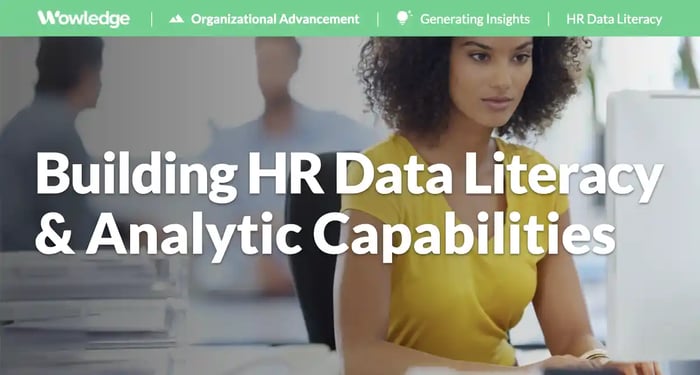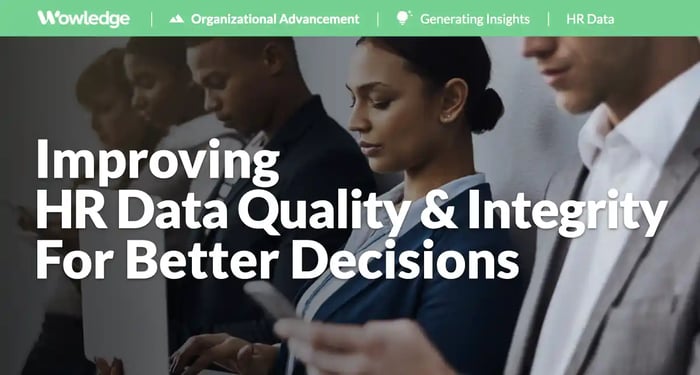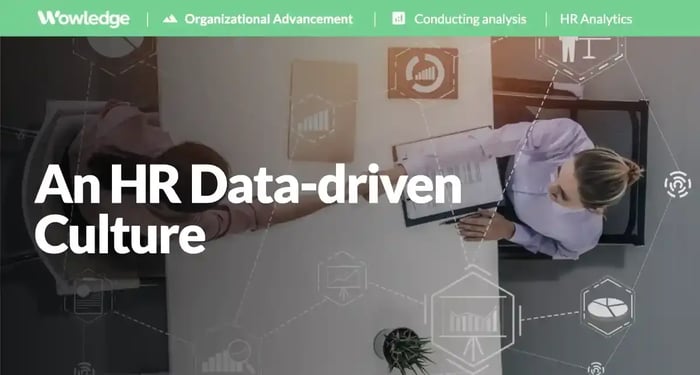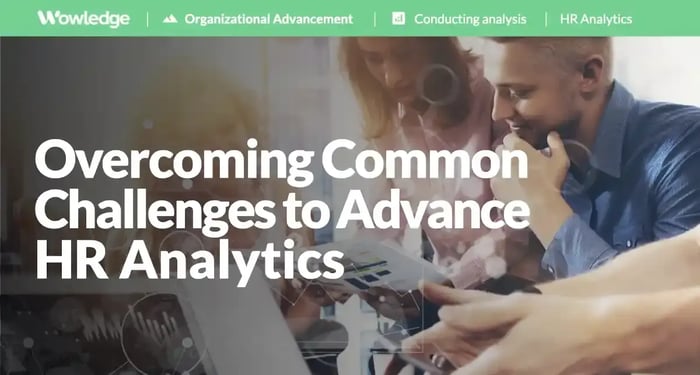Table of Contents
- Understanding HR data literacy
- Why data literacy is so important to HR functions
- The benefits of HR data literacy
- Identifying and developing HR data literacy skills
- Literacy relies upon the use of technologies
- Steps to building HR data literacy across the organization
- Final thoughts on building HR data literacy across an organization
- Relevant Practices & Tools
- About Wowledge
The development and deployment of meaningful and high-quality HR analytics and reporting have been a source of consternation and hand-wringing by HR leaders, researchers, and pundits for years. The picture has not improved appreciably, as a surprisingly low percentage of organizations report having solid people analytics capabilities. For example, LinkedIn found that only 22% of companies have adopted HR analytics. Furthermore, Deloitte has reported that as few as 8% of companies are able to utilize the data, and only 9% understand which talent dimensions drive actual employee performance. Research from Brandon Hall Group reported that less than 16% of companies were able to identify measures (much less create and report on those) related to the efficiency, effectiveness, talent, or business impact of any of their learning activities. A severe lack of HR data literacy is one foundational reason for many of these issues.
Despite these difficulties, the emergence of more advanced analytics platforms and embedded capabilities within HRIS and talent management systems, added to the rise of generative AI (GenAI) tools such as ChatGPT, Gemini, and Claude, has moved the needle. With these intelligent capabilities, many HR professionals no longer need to have expertise on HR data and storage structures, statistical methods, or reporting and visualization techniques to generate foundational insights. Despite the well-documented issues that create barriers to the successful deployment of analytics in HR, which often begin with HR role requirements and job skill standards, the challenge now can be focused on HR data literacy.
Understanding HR data literacy
HR data literacy refers to the extent to which an HR professional, team, or organization possesses the skills and capabilities necessary to review data and analyses and be able to:
- understand
- interpret
- extract relevant insights
- make informed decisions
- develop effective strategies
- communicate the rationale and learnings
What this means for the HR leader and professional is that they need to, at a minimum, be able to 1) use the data and analytics that are provided to them to identify issues, occurrences, and trends, 2) make educated inferences about the root causes of those, 3) identify solution options, and 4) effectively share those insights and resolutions to line and HR management.
In this way, HR data literacy focuses on the proper awareness and use of data and analysis, rather than generating it. It does not necessarily cover data analytic design and production skills that are required steps, and must be performed by others (typically in HRIS or IT functions), such as:
- Problem definition and framing
- Data sourcing and extraction
- Data cleansing and validation
- Data (e.g., statistical) analysis
- Visualizations and reports creation
- Analysis and report distribution
- Narrative development
For certain roles (e.g., HRBPs) and in specific HR operating models (e.g., COEs or People Analytics functions), some analytics production and design are required to support their work. In particular, “problem definition and framing” engages them in contextualizing the issue(s) relative to or as business-restraining issues, such as understanding high-performer turnover that impacts required production schedules or volumes. As such, problem definition is often included as an element of HR data literacy.
Why data literacy is so important to HR functions
Given the reams of data generated and updated daily for every employee, and the continued growth of available HR technologies, organizations are expanding the amount of information they collect and process. Consider the actions and transactions captured related to candidate and employee screening and selection, hiring, time and attendance, pay, time off, benefits, performance reviews, disciplinary actions, learning activities, transfers, and promotions. Leveraging the sheer volume of information and the associated insights that can be generated requires attention and skills that many HR teams lack.
Sadly, the ability of many in HR to use all that data for understanding trends, making higher-quality decisions, and developing targeted solutions is not keeping pace with the increased availability of data and supporting systems.
With pressures persisting to demonstrate value-added and business impact, HR functions can address those with better-skilled and prepared individuals and teams. What HR data literacy offers is the opportunity to introduce and embed more factual, evidence-based understandings of real (root) causes, which can bring greater objectivity and accuracy to solutions that address these causes, providing more effective decision support and issue resolution. These can start by focusing on the efficiency and effectiveness of HR processes and services, and extend to business outcome-impacting solutions. The latter better aligns HR planning and execution with the organization’s commercial objectives, such as when HR data literacy is leveraged in conjunction with the use of a balanced HR scorecard or OKRs.
The benefits of HR data literacy
The benefits of high HR data literacy in terms of talent and business outcomes have been demonstrated to be substantial. For example, Workday reported that companies that rely upon people or talent analytics for HR and business strategies and decision-making generate 82% higher profit versus the average over a three-year period. Tableau reports that these companies enjoy faster and more accurate decision-making, increased innovation, and higher productivity. Additionally, those organizations were 31% more likely to report higher customer satisfaction, 46% more likely to experience lower costs, and 58% more likely to achieve higher revenues.
Similarly, Bersin by Deloitte research found that “highly mature” people analytics organizations earned twice the revenue and cash flow from operations, and 1.8 times the gross margin or profit compared to companies of low HR analytics maturity.
While the value of high HR data literacy and its use in assessing and resolving people and operational challenges is substantial, the capability in many HR functions is sorely lacking.
That said, creating an environment where HR professionals—from top to bottom—use data insights to drive more objective, fact-based decisions and program designs is a significant differentiator. The primary benefits lie in its power to build HR credibility by shifting the traditional employee and manager perception of HR (and much related to their own people management) away from “soft and mushy”, “too hard to measure”, and “better to lead by feel, instinct, and experience”. Creating that environment is known as building an HR data-driven culture, which has been demonstrated to significantly enhance HR’s business credibility and value proposition.

Identifying and developing HR data literacy skills
Building the necessary HR data literacy capabilities and skills requires a commitment to training and deploying the proper tools, which starts with identifying the specific skills that should be targeted. A well-defined strategy should be developed that clarifies performance expectations for each HR function and role, the associated skills required for success, and the tools and capabilities to be deployed in support of those.
For example, the literacy requirements for an HRBP will differ significantly from those of a compensation analyst or a recruiting manager, which in turn will differ from those of an HR analytics specialist. In each case, a clear statement must be articulated on how the role holder will be expected to use data and analytics, what support and resources they will require, and who will provide those resources. In each case, a list of core capabilities can be developed, ranging from reading and interpreting existing reports to generating statistical analyses and managing combined HR and business databases used for analysis.
While the skills needed for full HR or people analytics functions can be substantial, the list of those involved in HR data literacy is relatively compact, and includes an understanding of how to:
- Understand the meaning and relevance of HR metrics and KPIs
- Access, review, and operate HR systems reports
- Interpret analyses and statistical results
- Extract relevant insights
- Make informed decisions
- Develop effective solutions and strategies
- Communicate the insights and learnings
Sadly, research HRCI found that HR staff in 60% of companies do not possess basic data literacy skills. Equally concerning is the observation by Tableau that only 26% of HR professionals have had training on data-based decision-making, 27% on how to read and interpret reports directly related to their work, and 19% on how to use basic data tools.
As crucial as an appreciation of the value and use of statistics and technologies is to HR data literacy, it also requires the motivation to learn, work, and act using data and more objective means. This often stems from curiosity about what is happening and why, and critical thinking, where those questions can only be answered by using logic and sound reasoning through analyzing information, evaluating the quality and meaning of the evidence, and considering potential reasons and options.
Literacy relies upon the use of technologies
At a minimum, an individual with HR data literacy understands not only the metrics being presented but also how to access and effectively utilize the systems relevant to their work. For many HR practitioners, this means being able to review and interpret data and analyses presented in a dashboard or report on a shared analytics platform, such as Microsoft Power BI or Tableau. Similarly, reporting modules may be accessed on the company's HRIS or HRMS, or specialized reports and trends can be found on an applicant tracking (ATS) or learning management (LMS) system.
An awareness of the range and types of systems will be needed by those whose work requires creating standard reports or specialized and tailored analyses. There are five primary categories of those systems or platforms, which ideally are integrated and can be used in a synchronized manner. They can be stand-alone or integrated platforms, as many available systems combine some or all of these capabilities, and include:
Collection and storage
These have workflows that capture and store data on the employees (demographics, skills, experiences), individual job data (classification, valuation, level, pay grade, and range), transactions (pay, leaves, benefits, performance, compensation, learning), and listening (opinions, reactions, ratings, and collaborations).
Analysis
These are analytic and statistical tools that review compiled information and identify trends, relationships, outliers, and other relevant observations.
Visualization and reporting
These presentation platforms take the analyzed data and offer ways to display them in tables, charts, or graphs of varying levels of sophistication and formats. Their power lies in presenting trends and relationships in an attractive and more easily interpretable manner to users of varying abilities.
External intelligence and benchmarking
A newer category of analytic technologies provides access to external labor market data that can be used to compare and contrast internal trends and events with those being experienced by other companies. Much like the benchmarking reports, databases, and platforms that have been in place for years, these provide context and comparisons against organizations that are similarly sized and scaled, from the same or related industries, or operating in the same geographic regions or countries. Both of these offer invaluable comparisons when evaluating internal results and presenting those to both HR and business leaders.

Steps to building HR data literacy across the organization
Establishing and sustaining HR data literacy throughout the function is essential for building a culture of data-driven decision-making. Its value is undeniable, as developing staff skills and expanding the use of objective insights builds HR’s credibility with its business partners and sets new standards for timely, well-designed, and accurate situational assessments and solutions. Eight key elements guide the journey of developing an organization-wide HR data literacy.
1. Define the strategy
A successful implementation requires a well-considered strategy that defines the purpose, creates a project plan, assigns responsibilities, and assesses how literacy is defined for every HR function and role. With that, changes to job requirements can be documented, skill development plans and resources can be created, and a change management strategy can be developed to promote awareness, acceptance, and adoption of those changes, making them supported and achievable.
2. Engage leadership
As this likely represents a cultural change, top and middle HR leaders must be brought along to buy in and support the changes that HR data literacy brings. Ultimately, they will need to be not only champions and vocal supporters, but also require their teams to utilize expertise, methods, and tools. Experience suggests that these changes will have a significant impact on them, and as a result, their compliance and active management cannot be presumed or expected. They will need to be brought into transparent governance processes to encourage and motivate their actions.
3. Hire and staff for literacy
Changing the culture and job requirements often requires an influx of new skills and talent to avoid the need for bringing all HR employees from novice to capable to expert levels. Hiring standards should be updated, with an eye on “seeding” each HR function or location team with one or more data-literate employees. As a result, preference should be given to new hire job candidates who possess existing analytical capabilities and a proven track record of success. Similarly, teams should be assessed for existing skills, with gaps noted, and as replacement hires or transfers are made, a preference should be given to those with suitable education and experience, including statistics, industrial-organizational psychology, or data science.
4. Train HR leaders and team members
Introductory overview. Training should always be preceded by required presentations, seminars, or webinars to introduce the HR team members to the purpose, vision, process, and timeframe for their upskilling. Question-and-answer sessions should be included.
Training regimen. A required set of training programs, which can be a combination of live or eLearning sessions that introduce the basic and best practices in HR data literacy. A modularized approach can be used to present personalized training pathways tailored to the needs of different leaders and professionals based on the demands of their roles. Example topics can include:
- Developing talent and business-related questions, and a hypothesis (What is happening? Why? What do I need to learn more about?)
- Data collection (What data do I need? What is available? Where is it located? How can I access it? Where can I compile data from different systems?)
- Data quality and integrity (How can I assess the consistency, accuracy of the data in the systems?)
- Data analysis (How to use statistics, including descriptive, diagnostic, predictive, or prescriptive, including analysis tools and software, and AI?)
- Data reporting and presentation (Selecting graphic representations and building a narrative or storytelling)
Training can be developed and delivered internally by subject matter experts, purchased from credible vendors, or outsourced to knowledgeable consultants. For more advanced requirements, external education can be accessed by universities (e.g., Cornell, UPenn/Wharton, Harvard), professional development organizations and consultancies (SHRM, HCI, HRCI, E&Y), or well-established online learning platforms (Coursera, Udemy).
Exposure opportunities. All learners should be provided ongoing access to the appropriate tools they will be asked to use in their work, including existing dashboards, tools, and applications. The creation of “sandbox” accounts and peer-led sessions can enable guided trial-and-error opportunities to use older versions of (or dummy) data relevant to their jobs without compromising active data.
Experience. Create opportunities for applying the tools and methods through actual on-the-job problem-solving. Develop small projects that utilize these tools to identify problems and their causes, and implement fixes related to process improvements, turnover, skill shortages, and other relevant issues. Have those employees present their findings and proposed solutions, along with explanations of what they did and what they discovered from using the data.
Update performance standards. Make changes as training and adoption levels increase to align with position descriptions, performance goals, and standards. Require the skills and demonstrated use of them for hiring, promotion, or transfer into senior HR and leadership roles, especially for HRBPs and expert specialists or COE leaders. Make the regular use of data-driven insights and solutions a standard approach for every issue (as appropriate and relevant) they encounter.
Reward and recognize. Be generous and public with those who have, acquire, and actively demonstrate their skills and expertise by utilizing their HR data literacy. Consider creating certification paths that can serve as motivators, a point of accomplishment, and a source of pride. For example, after completion of the training sequence for their job, and an associated project that demonstrates their HR data literacy, a “badge” as a “Certified HR Data Specialist” could be followed by advanced training and five successful projects, which would qualify them as a “Certified HR Data Wrangler”, followed by certification as a “Master HR Data Professional” after they act as expert guide for 10 teams in training and lead 20 data-focused projects.
Final thoughts on building HR data literacy across an organization
- Encourage curiosity and thoughtful questioning about root causes, why things are the way they are, and how they might be fixed beyond what meets the eye or has been experienced in the past.
- Understand that not everyone has the aptitude, motivation, or talent for adopting or gaining HR data literacy. Therefore, a fair, equitable, and reasonable policy or practice should be created to determine if their lack of the core skills will hold them back or deny them future growth and advancement opportunities.
- Consider creating a “center of expertise” with centralized data and analytic access, tools, methods, and development, but distributed headcount, and local “freedom within a framework to enable practices tailored to local requirements.
- Insist on a focus on outcomes where the assessment of the impact of HR and management practices on financial, operational, and market results is prioritized.
Relevant Practices & Tools
Emerging HR Metrics and Reporting Practices to Drive Situation Assessment and Actionable Insights for Managers and Leaders. >
HR Metrics & Reporting is a standardized and structured experience for both developers and users of the data and reports... more »
Developing a Company-wide Culture of Data-based HR Decision Making. >
Producing reports is only the beginning. Many large and successful companies still struggle to use reports during decision-making as a part of the widespread fabric of managerial behavior... more »
Creating a Dedicated, Cross-functional Analytics Team to "Own", Manage and Evolve HR Analytics Capabilities. >
Building robust, reliable, and best-in-class HR Metrics & Reporting capabilities requires the right talent with the right skills... more »
Selecting Optimal HR Technologies to Streamline Operations and Improve Talent Outcomes. >
The automation of HR has evolved significantly from its modest start half a century ago with payroll systems to its explosion of HR systems and applications with the availability of mainframes, personal computers, and now, cloud computing and widespread AI capabilities... more »
The 5 Whys Exercise: Identify and Address Root Causes of Workplace Challenges by Systematically Questioning Underlying Factors. >
This tool helps users overcome assumptions while reviewing the facts related to a wellness or other type of workplace challenge... more »
About Wowledge
Wowledge is the implementation-first platform designed for lean HR teams and consultants who need to design and scale strategic HR programs efficiently—without starting from scratch.
Our members gain access to continuously updated best practices, step-by-step guidance, expert-built tools, and customizable templates—all structured to accelerate the development and implementation of key HR programs.
Recognizing that every organization operates at different levels of sophistication, Wowledge’s scalable system of best practices follows a stage-based approach—Core, Advanced, and Emerging—ensuring HR professionals can implement solutions tailored to their organization’s unique needs and goals.
Your Shortcut to Amplifying HR Impact!
Get started for FREE! Learn more.










